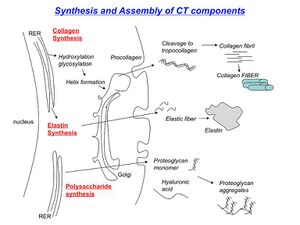Fibroblast: Difference between revisions
No edit summary |
No edit summary |
||
| Line 16: | Line 16: | ||
Connective tissue repair is carried out by new fibroblasts which are derived from cells called pericytes. Pericytes are embedded in the basement membrane of blood capillaries These new fibroblasts then migrate into wounds, following injury, and helping repair the damage.<ref>Histology Leeds Fibroblasts Available: https://www.histology.leeds.ac.uk/tissue_types/connective/connective_tissue_fibros.php (accessed 26.6.2022)</ref> Contractile fibroblasts, called myofibroblasts are also often generated, and these help to contract wounds. | Connective tissue repair is carried out by new fibroblasts which are derived from cells called pericytes. Pericytes are embedded in the basement membrane of blood capillaries These new fibroblasts then migrate into wounds, following injury, and helping repair the damage.<ref>Histology Leeds Fibroblasts Available: https://www.histology.leeds.ac.uk/tissue_types/connective/connective_tissue_fibros.php (accessed 26.6.2022)</ref> Contractile fibroblasts, called myofibroblasts are also often generated, and these help to contract wounds. | ||
Obtained from a person through a simple skin biopsy, fibroblasts can be grown in the laboratory for use in genetic and other scientific studies of that individual. | Obtained from a person through a simple skin biopsy, fibroblasts can be grown in the laboratory for use in genetic and other scientific studies of that individual. In recent years, studies on reprogramming human fibroblasts into neurons or heart cells have emerged.<ref>Xu, Z., Su, S., Zhou, S. ''et al.'' How to reprogram human fibroblasts to neurons. ''Cell Biosci'' 10, 116 (2020).Available: https://doi.org/10.1186/s13578-020-00476-2 (accessed 26.6.2022)</ref> | ||
== Terminology == | == Terminology == | ||
Revision as of 06:33, 26 June 2022
Original Editor - Lucinda hampton
Top Contributors - Lucinda hampton, Vidya Acharya and Kim Jackson
Introduction[edit | edit source]
Fibroblasts are the most common cell in connective tissue and connective tissues permanent residents. They secrete the fibers (notably collagen and elastin) and ground substance of the extracellular matrix.
Fibroblasts are often spindle-shaped with an elongated nucleus. When active fibroblasts are easily recognized by their abundant rough endoplasmic reticulum and prominent Golgi apparatus.[1]
Adaptability[edit | edit source]
Fibroblasts are known for their ability to change function. Adipocytes, pericytes, endothelial and epithelial cells can de-differentiate into fibroblasts. Stimulation of fibroblasts further increases vulnerability to epigenetic modifications. The ability of fibroblasts to transform is partly due to the variety of cell-surface adhesion receptors that facilitate the communication of fibroblasts with their surroundings. An example is the fibroblast transformation into the myofibroblast, essential in wound healing.[2]
Connective Tissue Repair[edit | edit source]
Connective tissue repair is carried out by new fibroblasts which are derived from cells called pericytes. Pericytes are embedded in the basement membrane of blood capillaries These new fibroblasts then migrate into wounds, following injury, and helping repair the damage.[3] Contractile fibroblasts, called myofibroblasts are also often generated, and these help to contract wounds.
Obtained from a person through a simple skin biopsy, fibroblasts can be grown in the laboratory for use in genetic and other scientific studies of that individual. In recent years, studies on reprogramming human fibroblasts into neurons or heart cells have emerged.[4]
Terminology[edit | edit source]
- Fibroblast: Synthetically active state
- Fybrocyte: Synthetically inactive state
- Tenoblast: specialised fibroblast
- Osteoblast: specialised fibroblast
- Myofibroblasts: contractile fibroblasts, having contractile properties, play a critical part in wound healing.
References[edit | edit source]
- ↑ Histology Guide Fibroblast Available: https://histologyguide.com//EM-view/EM-006-fibroblast/03-photo-1.html (accessed 26.6.2022)
- ↑ Dick MK, Miao JH, Limaiem F. Histology, Fibroblast. [Updated 2022 May 8]. In: StatPearls [Internet]. Treasure Island (FL): StatPearls Publishing; 2022 Jan Available:https://www.ncbi.nlm.nih.gov/books/NBK541065/ (accessed 26.6.2022)
- ↑ Histology Leeds Fibroblasts Available: https://www.histology.leeds.ac.uk/tissue_types/connective/connective_tissue_fibros.php (accessed 26.6.2022)
- ↑ Xu, Z., Su, S., Zhou, S. et al. How to reprogram human fibroblasts to neurons. Cell Biosci 10, 116 (2020).Available: https://doi.org/10.1186/s13578-020-00476-2 (accessed 26.6.2022)







